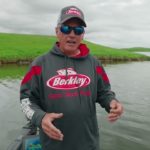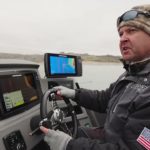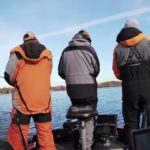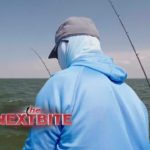Finding Hard to Find Walleyes
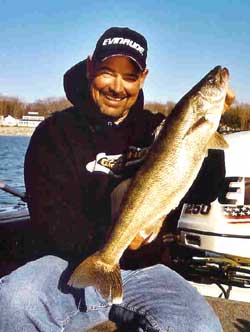 Here today, gone tomorrow. It’s the way of the walleye when it comes to early fall walleyes, but it’s not all bad. If you can read the conditions and anticipate their movements you can cash in, and sometimes with a vengeance.
Here today, gone tomorrow. It’s the way of the walleye when it comes to early fall walleyes, but it’s not all bad. If you can read the conditions and anticipate their movements you can cash in, and sometimes with a vengeance.
Late summer and early fall and be a challenging time, as walleye location and attitude may vary drastically. Mid to late summer usually makes for tougher walleye fishing, wherever you are. Instead of being bunched up in nice, neat, little specific areas, they can be spread out. Fish that are spread out can be difficult to catch, and the odds start to work against you. When walleyes feed, they don’t all do it at the same time. Rather, some will be feeding actively, some will be starting to get in the mood but won’t move far to take a bait, and some will be totally inactive. Without the advantage of a concentration of fish, you may have to get your bait in front of too many to find the takers.
By late summer and early fall things start to change, and change for the better. Water temps begin to cool off and fish start showing up in concentrations, once again. Walleyes that have been hanging out in their deeper off shore home for the summer make a move back in on the rock reefs, bars and shorelines, as well as weedlines that are still green and healthy. When they finally arrive they’ll be joining shallow fish that never left and have spent the entire summer in shallow water. When that happens you have the beginning of another concentration, which can put the odds in your favor.
One of the differences between how walleyes relate to early season structure, versus late, is the fact that they tend to move a little more shallow when they get active. Instead of finding walleyes on the deep edge of the first break of a rocky ledge late summer walleyes will move right up on top of shallow structures and can be found in just a few feet of water.
One of the keys to triggering a good late summer shallow water bite is water clarity. Most good walleye lakes start the year out with fairly clear water conditions, but as the season progresses and the summer sun bears down and pushes water temps into the lukewarm range, algea blooms begin to explode and the water clarity becomes greatly diminished. With visibility reduced, walleyes may make shallow feeding movements during the middle of the day. The darker the water becomes the more likely you are to find good daytime action. Lakes that remain clear throughout the season, still see the deep to shallow migration; However, walleyes will be Glass Shad Rapless apt to feed during the day, and more likely to become active after dark.
Finding active daytime walleyes, requires a presentation that will let you cover water quickly. One of the fastest to ways to a bunch of late summer ‘eyes, is trolling Shad Raps. The Shad Rap is the perfect bait for trolling shallow water. Shad Raps have probably accounted for the early demise of more shallow water walleyes than all other crankbaits combined.
 When anglers start learning the lessons of trolling crankbaits, they often second guess themselves, and may lack confidence in their bait selection. By putting the Shad Rap to work, you can spend more time concentrating on where you put the bait, instead of what bait your are currently using. If you pull Shad Raps through a likely looking area, and find no takers, you can be confident that there wasn’t any active fish present, and should keep on going.
When anglers start learning the lessons of trolling crankbaits, they often second guess themselves, and may lack confidence in their bait selection. By putting the Shad Rap to work, you can spend more time concentrating on where you put the bait, instead of what bait your are currently using. If you pull Shad Raps through a likely looking area, and find no takers, you can be confident that there wasn’t any active fish present, and should keep on going.
Shallow water walleyes tend to hang tight to the available cover, and the key to successful trolling includes getting a bait to run at ’eye level. That means selecting a crankbait that will run close to the bottom, without constantly digging in. Shad Raps in sizes 5’s, 7’s and 9’s, will cover just about any situation you may be faced with. The number five Shad can get you into five feet of water, or less, the Seven can cover five to maybe ten, and the Nine can get you to twenty feet and deeper, depending on what line your using.
By combining a crankbait with one of the new braided lines, you can achieve extraordinary diving depths, and may get you up to an additional ten feet of depth. Another super braid attribute is the fact that it transfers the action of the bait, to the rod tip, like nothing else. When running crankbaits close to structure, you’re going to pickup some junk like moss or weeds, and a fowled bait won’t get bit. When a bait picks up debris you can see it in your rod tip. The bait doesn’t vibrate as hard and the rod tip loses it’s rhythmic twitch; Time to reel it in and clean it off.
Shallow water walleyes can be extremely spooky, and it may take some extra line to get the bait back, and away, from the boat, to get them to take your offering. To keep your boat out of the fish holding areas, you may want employ the use of a side planer, or trolling board. One of the small boards, that attaches directly to the line, can get the job done, and will keep your boat completely out of the picture. The only problem is that fact that you lose the ability to see the action in the rod tip. If you feel the need to use a side planer, you’ll just have to reel in the whole works, occasionally, to make sure you’re running clean.
While trolling crankbaits may be the most effective way to find walleyes, there might be better and quicker ways to put them in the boat. For example, let’s say that every time you pull your bait across a certain pointyou nail a fish. You may be better off marking the spot, and going back to work it with a jig and live bait combo. Or maybe you’ll want cast a crankbait to the spot on the spot, and concentrate your fishing time working the most productive area. Or maybe you’ll decide to stay with what your doing because it’s working; Whatever it takes.
One of the best things about fishing, come early fall is the lack of other anglers. In fact, there may be days when you have an entire lake to yourself. Just because nobody’s fishing doesn’t mean the fish are gone. You can bet they’re there and by staying with it you just might find some of the hottest action of the entire year.


